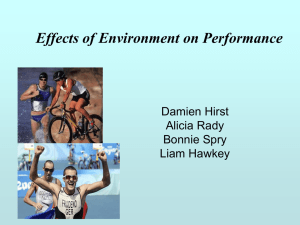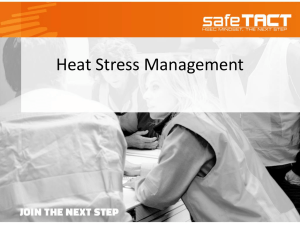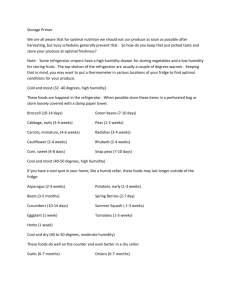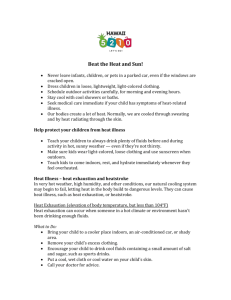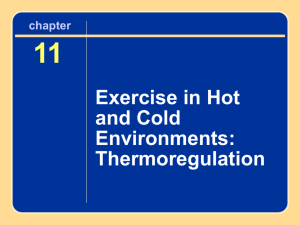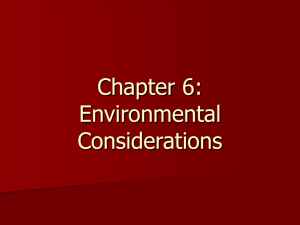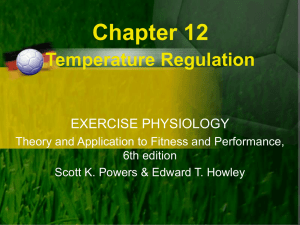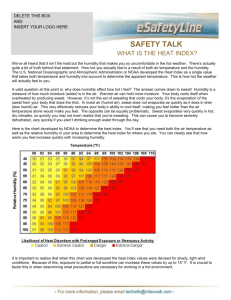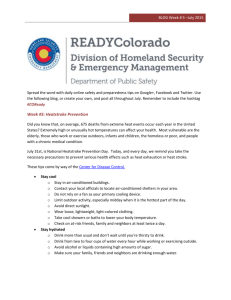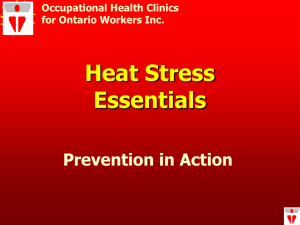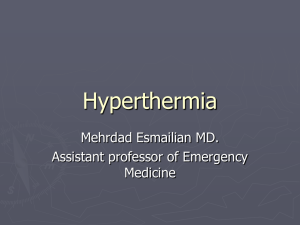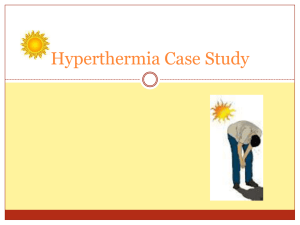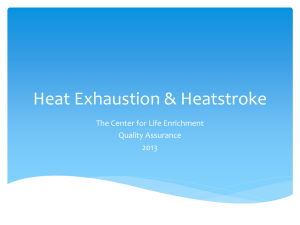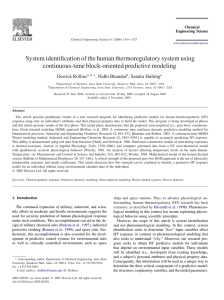RRCA HOT WEATHER RUNNING TIPS
advertisement
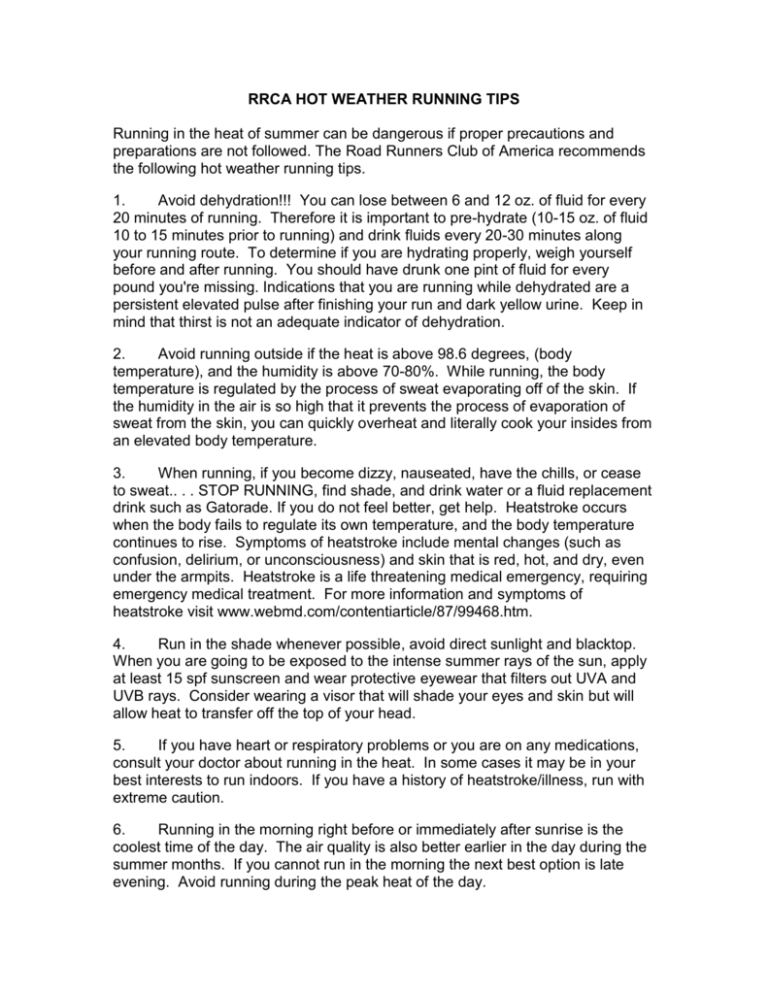
RRCA HOT WEATHER RUNNING TIPS Running in the heat of summer can be dangerous if proper precautions and preparations are not followed. The Road Runners Club of America recommends the following hot weather running tips. 1. Avoid dehydration!!! You can lose between 6 and 12 oz. of fluid for every 20 minutes of running. Therefore it is important to pre-hydrate (10-15 oz. of fluid 10 to 15 minutes prior to running) and drink fluids every 20-30 minutes along your running route. To determine if you are hydrating properly, weigh yourself before and after running. You should have drunk one pint of fluid for every pound you're missing. Indications that you are running while dehydrated are a persistent elevated pulse after finishing your run and dark yellow urine. Keep in mind that thirst is not an adequate indicator of dehydration. 2. Avoid running outside if the heat is above 98.6 degrees, (body temperature), and the humidity is above 70-80%. While running, the body temperature is regulated by the process of sweat evaporating off of the skin. If the humidity in the air is so high that it prevents the process of evaporation of sweat from the skin, you can quickly overheat and literally cook your insides from an elevated body temperature. 3. When running, if you become dizzy, nauseated, have the chills, or cease to sweat.. . . STOP RUNNING, find shade, and drink water or a fluid replacement drink such as Gatorade. If you do not feel better, get help. Heatstroke occurs when the body fails to regulate its own temperature, and the body temperature continues to rise. Symptoms of heatstroke include mental changes (such as confusion, delirium, or unconsciousness) and skin that is red, hot, and dry, even under the armpits. Heatstroke is a life threatening medical emergency, requiring emergency medical treatment. For more information and symptoms of heatstroke visit www.webmd.com/contentiarticle/87/99468.htm. 4. Run in the shade whenever possible, avoid direct sunlight and blacktop. When you are going to be exposed to the intense summer rays of the sun, apply at least 15 spf sunscreen and wear protective eyewear that filters out UVA and UVB rays. Consider wearing a visor that will shade your eyes and skin but will allow heat to transfer off the top of your head. 5. If you have heart or respiratory problems or you are on any medications, consult your doctor about running in the heat. In some cases it may be in your best interests to run indoors. If you have a history of heatstroke/illness, run with extreme caution. 6. Running in the morning right before or immediately after sunrise is the coolest time of the day. The air quality is also better earlier in the day during the summer months. If you cannot run in the morning the next best option is late evening. Avoid running during the peak heat of the day. 7. DO wear light colored breathable clothing. DO NOT wear long sleeves or long pants or sweat suits. Purposefully running in sweat suits on hot days to lose water weight is dangerous! 8. Plan your route so you can refill water bottles or find drinking fountains. City parks, local merchants, and restaurants are all good points to incorporate on your route during hot weather running. Be sure to tell someone where you are running how long you think you will gone, and carry identification. Stay hydrated, cool, and safe this summer! Excerpts From “Running in The Heat” By Patti and Warren Finke, Team Oregon PERFORMANCE Several studies have shown that the optimum temperature for long distance running performance seems to be around 50-55 degrees Fahrenheit. Above and below this range performances degrade as much as 2% for every 5 degrees. Three additional environmental factors can interact to alter performance further. They are relative humidity, air movement, and radiation. High humidity, because it inhibits evaporation, has the same effect as increasing the ambient temperature. This effect is worse for higher temperatures where it can increase the effective ambient temperature by as much as 10 degrees. Air movement over the body enhances the ability to lose heat by convection and evaporation. Movement is generated both by the runners speed and by any prevailing wind. These can combine to lower the effective temperature by as much as 8 or 9 degrees while increasing evaporation and fluid loss. Running downwind cancels out this cooling effect. Direct sunlight adds heat to the body by radiation. The effective temperature increase can be as much as 8 or 9 degrees. It is easy to see that by combining 80+ degree temperatures with direct sun exposure and high humidity serious performance degradation will occur in long distance races. HEAT ILLNESSES Special caution should be advised when the temperature is above 80ºF or when the relative humidity exceeds 50-60%. Running unwisely under environmental heat stress may lead to a variety of heat illnesses which can be life threatening. These illnesses are caused by three factors: increased core temperature, loss of body fluids, and loss of electrolytes. While running in the heat, monitor your condition for signs of weakness, dizziness, nausea, disorientation, cessation of sweating and piloerection, (the standing up of body hairs). If these signs occur, stop running and start the appropriate treatment. They could be symptoms of any of the major heat illnesses described below. Heat Cramps Salts can be lost in the sweat while running in the heat. If they are not replenished properly, muscle paid and cramps can occur. The body temperature does not become elevated. Prevention can come from heat acclimatization, ingestion of large amounts of water and by increasing the daily salt intake several days before the heat stress. Treatment is rest in a cool environment and replacement of lost salts. Heat Exhaustion Poor circulatory response to heat and reduction of blood volume due to increased sweating can lead to symptoms of general weakness, dizziness and nausea. The skin is usually cool and pale, but the person is probably still sweating. Body temperature is not elevated to dangerous levels (under 106ºF). Exercise must be stopped. Treat by rest in a cool environment, ingestion of cool liquids and cooling the body externally with water or ice. Heat Stroke When the body’s temperature regulating system fails, excessively high body temperature and heat stroke can result. This is a serious condition which, if untreated, may well lead to death. It requires IMMEDIATE medical attention. The symptoms are dry, warm and red skin, a reduction or loss of sweat and a body core temperature over 106ºF. Treatment is to immediately stop exercise, seek medical attention and start cooling the body with ice packs and cold water. The person may or may not be conscious. Cool liquids may be consumed if the person is conscious.
